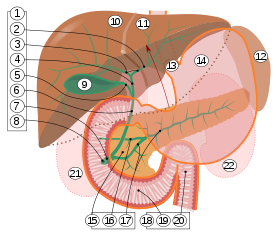Intrahepatic bile ducts
Appearance
(Redirected from Interlobar bile ducts)
This article needs additional citations for verification. (December 2009) |

2. Intrahepatic bile ducts
3. Left and right hepatic ducts
4. Common hepatic duct
5. Cystic duct
6. Common bile duct
7. Ampulla of Vater
8. Major duodenal papilla
9. Gallbladder
10–11. Right and left lobes of liver
12. Spleen
13. Esophagus
14. Stomach
15. Pancreas:
16. Accessory pancreatic duct
17. Pancreatic duct
18. Small intestine:
19. Duodenum
20. Jejunum
21–22. Right and left kidneys
The front border of the liver has been lifted up (brown arrow).[1]
Intrahepatic bile ducts compose the outflow system of exocrine bile product from the liver.
They can be divided into:[2]
- Lobar ducts (right and left hepatic ducts) - stratified columnar epithelium.
- Interlobar ducts (between the main hepatic ducts and the interlobular ducts) - pseudostratified columnar epithelium.
- Interlobular bile ducts (between the interlobar ducts and the lobules) - simple columnar epithelium.
- Intralobular bile ducts (cholangioles or Canals of Hering) - simple cuboidal epithelium, then by hepatocytes
- Bile canaliculi - two half-canaliculi formed by the hepatocytes facing the perisinusoidal space

References
[edit]- ^ Standring S, Borley NR, eds. (2008). Gray's anatomy : the anatomical basis of clinical practice. Brown JL, Moore LA (40th ed.). London: Churchill Livingstone. pp. 1163, 1177, 1185–6. ISBN 978-0-8089-2371-8.
- ^ Roderick N. M. MacSween; Alastair D. Burt; Bernard Portmann; Linda D. Ferrell (2007). MacSween's pathology of the liver. Elsevier Health Sciences. p. 518. ISBN 978-0-443-10012-3.
